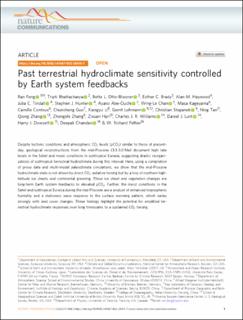| dc.contributor.author | Feng, Ran | |
| dc.contributor.author | Bhattacharya, Tripti | |
| dc.contributor.author | Otto-Bliesner, Bette L. | |
| dc.contributor.author | Brady, Esther C. | |
| dc.contributor.author | Haywood, Alan M. | |
| dc.contributor.author | Tindall, Julia C. | |
| dc.contributor.author | Hunter, Stephen J. | |
| dc.contributor.author | Abe-Ouchi, Ayako | |
| dc.contributor.author | Chan, Wing-Le | |
| dc.contributor.author | Kageyama, Masa | |
| dc.contributor.author | Contoux, Camille | |
| dc.contributor.author | Guo, Chuncheng | |
| dc.contributor.author | Li, Xiangyu | |
| dc.contributor.author | Lohmann, Gerrit | |
| dc.contributor.author | Stepanek, Christian | |
| dc.contributor.author | Tan, Ning | |
| dc.contributor.author | Zhang, Qiong | |
| dc.contributor.author | Zhang, Zhongshi | |
| dc.contributor.author | Han, Zixuan | |
| dc.contributor.author | Williams, Charles J. R. | |
| dc.contributor.author | Lunt, Daniel J. | |
| dc.contributor.author | Dowsett, Harry J. | |
| dc.contributor.author | Chandan, Deepak | |
| dc.contributor.author | Peltier, W. Richard | |
| dc.date.accessioned | 2022-06-14T07:18:22Z | |
| dc.date.available | 2022-06-14T07:18:22Z | |
| dc.date.created | 2022-06-02T14:19:36Z | |
| dc.date.issued | 2022 | |
| dc.identifier.citation | Nature Communications. 2022, 13 (1), . | en_US |
| dc.identifier.issn | 2041-1723 | |
| dc.identifier.uri | https://hdl.handle.net/11250/2998606 | |
| dc.description.abstract | Despite tectonic conditions and atmospheric CO2 levels (pCO2) similar to those of present-day, geological reconstructions from the mid-Pliocene (3.3-3.0 Ma) document high lake levels in the Sahel and mesic conditions in subtropical Eurasia, suggesting drastic reorganizations of subtropical terrestrial hydroclimate during this interval. Here, using a compilation of proxy data and multi-model paleoclimate simulations, we show that the mid-Pliocene hydroclimate state is not driven by direct CO2 radiative forcing but by a loss of northern high-latitude ice sheets and continental greening. These ice sheet and vegetation changes are long-term Earth system feedbacks to elevated pCO2. Further, the moist conditions in the Sahel and subtropical Eurasia during the mid-Pliocene are a product of enhanced tropospheric humidity and a stationary wave response to the surface warming pattern, which varies strongly with land cover changes. These findings highlight the potential for amplified terrestrial hydroclimate responses over long timescales to a sustained CO2 forcing. | en_US |
| dc.language.iso | eng | en_US |
| dc.rights | Navngivelse 4.0 Internasjonal | * |
| dc.rights.uri | http://creativecommons.org/licenses/by/4.0/deed.no | * |
| dc.title | Past terrestrial hydroclimate sensitivity controlled by Earth system feedbacks | en_US |
| dc.title.alternative | Past terrestrial hydroclimate sensitivity controlled by Earth system feedbacks | en_US |
| dc.type | Peer reviewed | en_US |
| dc.type | Journal article | en_US |
| dc.rights.holder | © The Author(s) 2022 | en_US |
| dc.description.version | publishedVersion | en_US |
| cristin.ispublished | true | |
| cristin.fulltext | original | |
| cristin.qualitycode | 2 | |
| dc.identifier.doi | 10.1038/s41467-022-28814-7 | |
| dc.identifier.cristin | 2029138 | |
| dc.source.journal | Nature Communications | en_US |
| dc.source.volume | 13 | en_US |
| dc.source.issue | 1 | en_US |
| dc.source.pagenumber | 11 | en_US |

